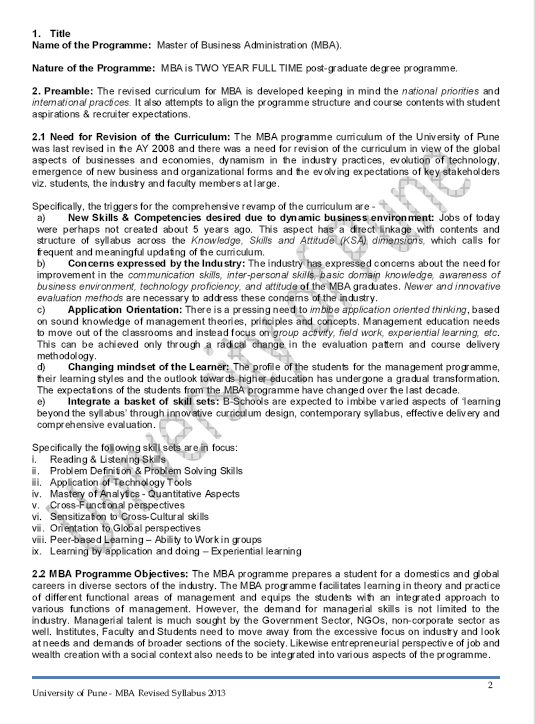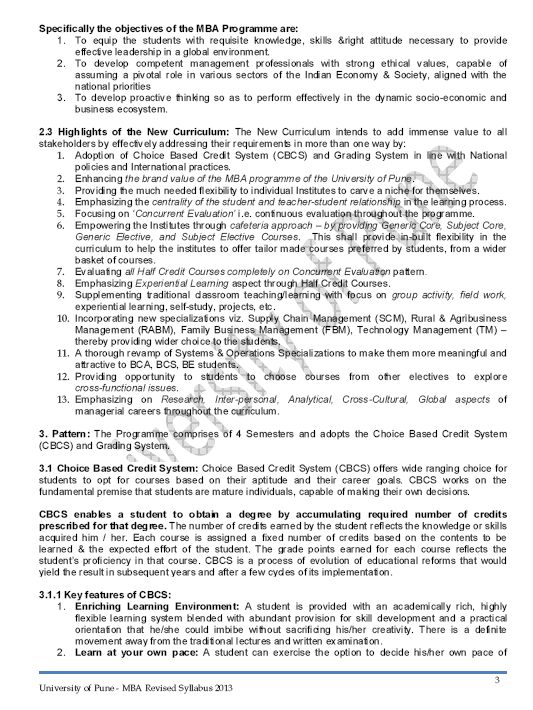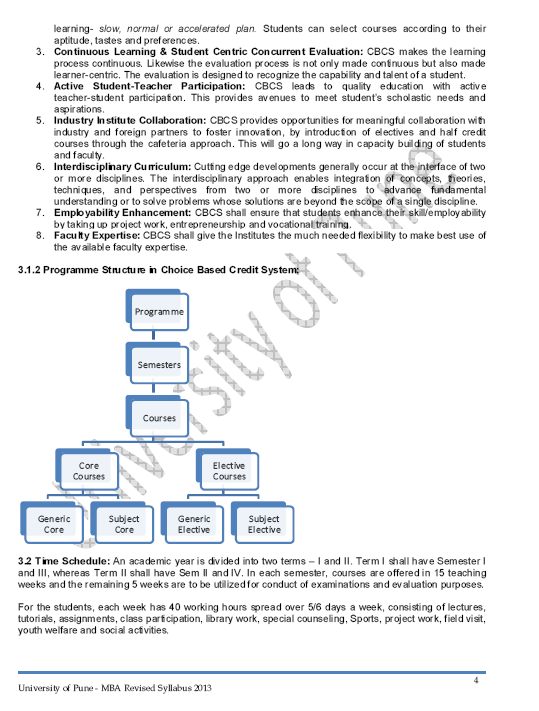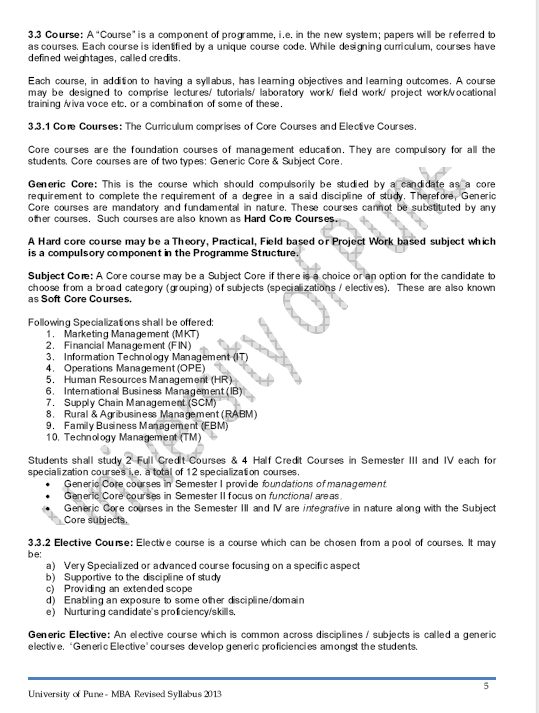|
#1
June 26th, 2014, 05:35 PM
| |||
| |||
| Best option after B.Tech - M.Tech or M.B.A
Which is the best option after B.Tech - M.Tech or M.B.A?????????? MBA & M.Tech both are 2 years durations Post graduation course which can be pursue after completion of B.Tech course Both MBA & M.Tech are good course and have equal scope and opportunities. Both courses have their own priorities; I will suggest you to go for that course in which your interest lies If you are interested in research and technical field, then go for M.Tech. But if you have leadership skills and interested in business set up then I will strongly recommend you to go for MBA course Final decision is totally yours which depends on your interest. Choose your interested course so that you can give your 100% for your reference here i am sharing M.Tech Syllabus with you please have a look on that Detailed Syllabus CSE101 : Algorithms and Algorithmic Complexity • Fundamentals of Mathematics: Linear Algebra, Combinatorics, Boolean Functions, Number Theory. • Fundamentals of Algorithms: Classification of Problems, Complexity, Asymptotic Notations. • Recurrences: Master Theorem • Probabilistic Analysis: Sort, Search, Random Binary Search trees, Red-black trees, Priority Queues, Bipartite Matching, Common Subsequence Problem, Flow Networks, Ford-Fulkerson Method, Fast Fourier Transforms, Knuth-Morris-Pratt Algorithm, Convex Hull, Point Location. • Combinatorial Algorithms: Generating Permutations, Generating Partitions. • Approximation Algorithms: Concept, Design, Applications. In approximability. Number -Theoretic Algorithms. Randomized Algorithms, Primality Testing, Constrained and Unconstrained Optimization, Evolutionary Algorithms. Books / References : 1. Introduction to Algorithms - T. H. Cormen, et. al. (PHI, 1990) 2. Algorithms for Hard Problems - J. Hromkovic (Springer) 3. Analysis of Algoriyhms & Data Structures - L. Banachowski, et. al. (Addison Wesley) CSE102 : Cryptography and Network Security • Principles of Security, Basic Cryptographic techniques, Classification of attacks, Virus, Worm, Trojan Horse, Spam etc. • Symmetric Key Cryptography : Algorithm types and modes, Cryptographic Algorithms • Asymmetric Key Cryptographic Algorithms, Digital Signature • Digital Envelope, Message Authentication Code, Message Digest • Public-Key Infrastructure (PKI) • Authentication: Classifications, Mutual authentication Algorithms, Kerberos • Security in layers and domains: IPsec, Secure Socket Layer (SSL), E-mail Security • Electronic transactions Books / References : 1. Cryptography and Network Security : Atul Kahate , TMH 2. Cryptography and Network Security : Principles & Practices : William Stallings, 4th Edition Pearson & Printice Hall 3. Network Security : Kaufman , Perlman, Speciner, Pearson Education CSE103 : Advanced Database Management Systems • Distributed Database: Distributed database architecture, levels of distribution transparency, DDB design, Translation of global queries, Query optimization for DDB, Concurrency control for DDB • Object Oriented Database: OO paradigm, OO data models: Object identifiers, Relationship and Integrity, ER Diagramming model for OO relationships, Object relational data models • Data Warehousing: Components, Building a data warehouse, Data extraction, cleanup and transformation, OLAP • Future Trends in data models: Semantic data models, DM for loosely structured data items, Multimedia database. Books / References : 1. Alex Berson, Stephen J Smith; "Data Warehousing, Data Mining, and OLAP"; Tata McGraw-Hill Publishing Company Limited, 1997, ISBN 0-07-058741-8 2. S Ceri, G Pelagatti; ""Distributed Databases: Principles and Systems"; Tata McGraw-Hill Publishing Company Limited, ISBN 0-07-066215-0 3. M Tamer Ozsu, P Valduriez; "Principles of Distributed Database Systems"; Pearson Education Pvt. Ltd., 2005, ISBN 81-7808-375-2. 4. J. L. Harrington; "Object Oriented Database Design Clearly Explained"; Morgan Kaufmann Publishers, 2001, ISBN 0-12-326428-6. 5. A K Majumder, P Bhattacharya; "Database Management Systems"; Tata McGraw-Hill Publishing Company Limited, 2004, ISBN 0-07-462239-0 CSE104(a) : Distributed Systems • Introduction: definition, characteristics and challenges of distributed systems, Architectural models (client-server). • Time: Physical and logical time, Event ordering, Clock Synchronization, Message delivery ordering. • Inter-process communication (sockets, UDP/TCP), Overview of middleware, Web services, RPC. • Operating system support - Mutual exclusion, termination detection, deadlock, process migration, replication management, threads, multi-threaded client/server. • Distributed file service (design options, file sharing, access control). • Distributed transactions (flat/nested, one/two phase commit). • Security - main threats and techniques for ensuring security (secure channels, firewalls). • Fault-tolerance and availability (passive/active replication, gossip architectures). • Applications. Pervasive computing environments: active office, home and city, Events, composite events, mobility and location-tracking, Electronic health, police and transport services. CSE104(b) : Bioinformatics • Basic Biology: What is life? The unity and the diversity of living things. Prokaryotes and Eukaryotes, Yeast and People, Evolutionary time and relatedness, Living parts: Tissues, cells, compartments and organelles, Central dogma of molecular biology, Concept of DNA, RNA, Protein and metabolic pathway. What is Bioinformatics? Recent challenges in Bioinformatics. • Biological databases: Their needs and challenges. Example of different biological databases – sequence, structure, function, micro-array, pathway, etc. • Sequence Analysis: Theory and Tools: -Pairwise alignment – Different local and global search alignment, Heuristic searches (like BLAST) applicable to search against database, Multiple alignment algorithms, Whole genome comparison. • Walk through the genome: Prediction of regulatory motifs, Operon, Gene, splices site, etc. • Markov models: Hidden Markov models – The evaluation, decoding and estimation problem and the algorithms. Application in sequence analysis. • Molecular phylogeny: maximum Parsimony, distance Matrix and maximum likelihood methods. Concepts of adaptive evolution. • Application of graph theory in Biology: Biochemical Pathway, Protein-protein interaction network, Regulatory network and their analysis. Books / References : 1. Bioinformatics: David Mount 2. Biological Sequence Analysis: Probabilistic Models of Proteins and Nucleic acids, R. Durbin, S.R. Eddy, A. Krogh and G. Mitchison. CSE104(c) : Soft Computing • Soft Computing: Introduction, requirement, different tools and techniques, usefulness and applications. • Fuzzy sets and Fuzzy logic: Introduction, Fuzzy sets versus crisp sets, operations on fuzzy sets, Extension principle, Fuzzy relations and relation equations, Fuzzy numbers, Linguistic variables, Fuzzy logic, Linguistic hedges, Applications, fuzzy controllers, fuzzy pattern recognition, fuzzy image processing, fuzzy database. • Artificial Neural Network: Introduction, basic models, Hebb's learning, Adaline, Perceptron, Multilayer feed forward network, Back propagation, Different issues regarding convergence of Multilayer Perceptron, Competitive learning, Self-Organizing Feature Maps, Adaptive Resonance Theory, Associative Memories, Applications. • Evolutionary and Stochastic techniques: Genetic Algorithm (GA), different operators of GA, analysis of selection operations, Hypothesis of building blocks, Schema theorem and convergence of Genetic Algorithm, Simulated annealing and Stochastic models, Boltzmann Machine, Applications. • Rough Set: Introduction, Imprecise Categories Approximations and Rough Sets, Reduction of Knowledge, Decision Tables, and Applications. • Hybrid Systems: Neural-Network-Based Fuzzy Systems, Fuzzy Logic-Based Neural Networks, Genetic Algorithm for Neural Network Design and Learning, Fuzzy Logic and Genetic Algorithm for Optimization, Applications. Books / References : 1. Neural Fuzzy Systems, Chin-Teng Lin & C. S. George Lee, Prentice Hall PTR. 2. Fuzzy Sets and Fuzzy Logic, Klir & Yuan, PHI, 1997. 3. Neural Networks, S. Haykin, Pearson Education, 2ed, 2001. 4. Genetic Algorithms in Search and Optimization, and Machine Learning, D. E. Goldberg, Addison-Wesley, 1989. 5. Neural Networks, Fuzzy logic, and Genetic Algorithms, S. Rajasekaran & G. A. V. Pai, PHI. 6. Neuro-Fuzzy and Soft Computing, Jang, Sun, & Mizutani, PHI. 7. Learning and Soft Computing, V. Kecman, MIT Press, 2001. 8. Rough Sets, Z. Pawlak, Kluwer Academic Publisher, 1991. 9. Intelligent Hybrid Systems, D. Ruan, Kluwer Academic Publisher, 1997. CSE104(d) : Multimedia Systems Books / References : CSE 105 (P) Systems Design Lab. - I : a)Hardware-oriented Application Lab b)Software-oriented Application Lab. MBA Syllabus please have a look on that      Last edited by Neelurk; March 31st, 2020 at 11:55 AM. |